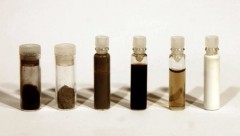Carbodeon is a supplier of carbon-based additives including detonation produced nanodiamonds (4-6 nm) that offer major upgrades in materials performance, but success in this sector isn’t as straightforward as simply demonstrating record-breaking properties.
“You have to create a situation where delivery is beneficial for everyone in the supply chain otherwise the material won’t make it to the end user,” Gavin Farmer, business development manager at Carbodeon, told TMR+.
Considerations include materials cost, availability and impact on manufacturing.
The firm offers chemically-treated nanodiamonds as suspensions (of small agglomerates) and dispersions (of individual particles) that can often be mixed directly with raw materials, and reduce the amount of specialized knowledge required by the customer. Powdered forms are also available, but typically the integration step takes longer to optimize.
For Carbodeon, the split between nanomaterials development and applications-related research is roughly 70/30.
Adoption by industry
The company provides samples of material to clients for assessment, but for this approach to succeed the customer must be willing to enter into a series of experiments and have the tools to validate the results. Also, clients may lack the deep scientific knowledge that could be required to absorb the technology, and require further support.
Where a strong market opportunity exists, Carbodeon will push further into the application area and pursue patent opportunities. This opens the door to licensing revenue and gives added value to the customer through exclusive use rights.
“Whenever you invest in applications-related research, you need to make sure that you can monetize the work,” adds Farmer.
Product development
Success stories for Carbodeon so far include electroplating, where nanodiamonds have been shown to nucleate grains of the coating material, which reduces cracking and ramps up the corrosion protection offered by the electroplated layer. The embedded particles also improve wear and reduce friction thanks to their materials properties.
A notable characteristic of diamond is its very high thermal conductivity, which is rare for materials that are electrically insulating. Carbodeon is working with developers to formulate superior thermal interface material (TIM) and easy-to-process heat sinks for managing cooling in electronics.
“We’ve taken polymers that contain thermal fillers, typically micron-sized boron nitride or alumina particles and milled them with nanodiamond (0.1% by weight),” said Farmer. “The much smaller diamond particles bridge gaps in the filler network to boost thermal conductivity by 25%.”
Driving down emissions
The firm’s latest product is dubbed uDiamond Vox D – a formulation that Carbodeon claims can double surface durability and reduce friction by up to 66 percent.
Pre-functionalized with a surface chemistry tailored to suit PTFE, the liquid dispersion of nanodiamonds can be mixed directly with industrial fluoropolymer coatings ready for application by spray or screen printing with little or no change to the process parameters.
“In automotive powertrains alone, the fuel and CO2 savings through friction reduction will make a real difference,” commented Farmer.
Further reading on the web –
Carbodeon Oy: Better heat conductivity extends equipment lifespan (Tekes)

